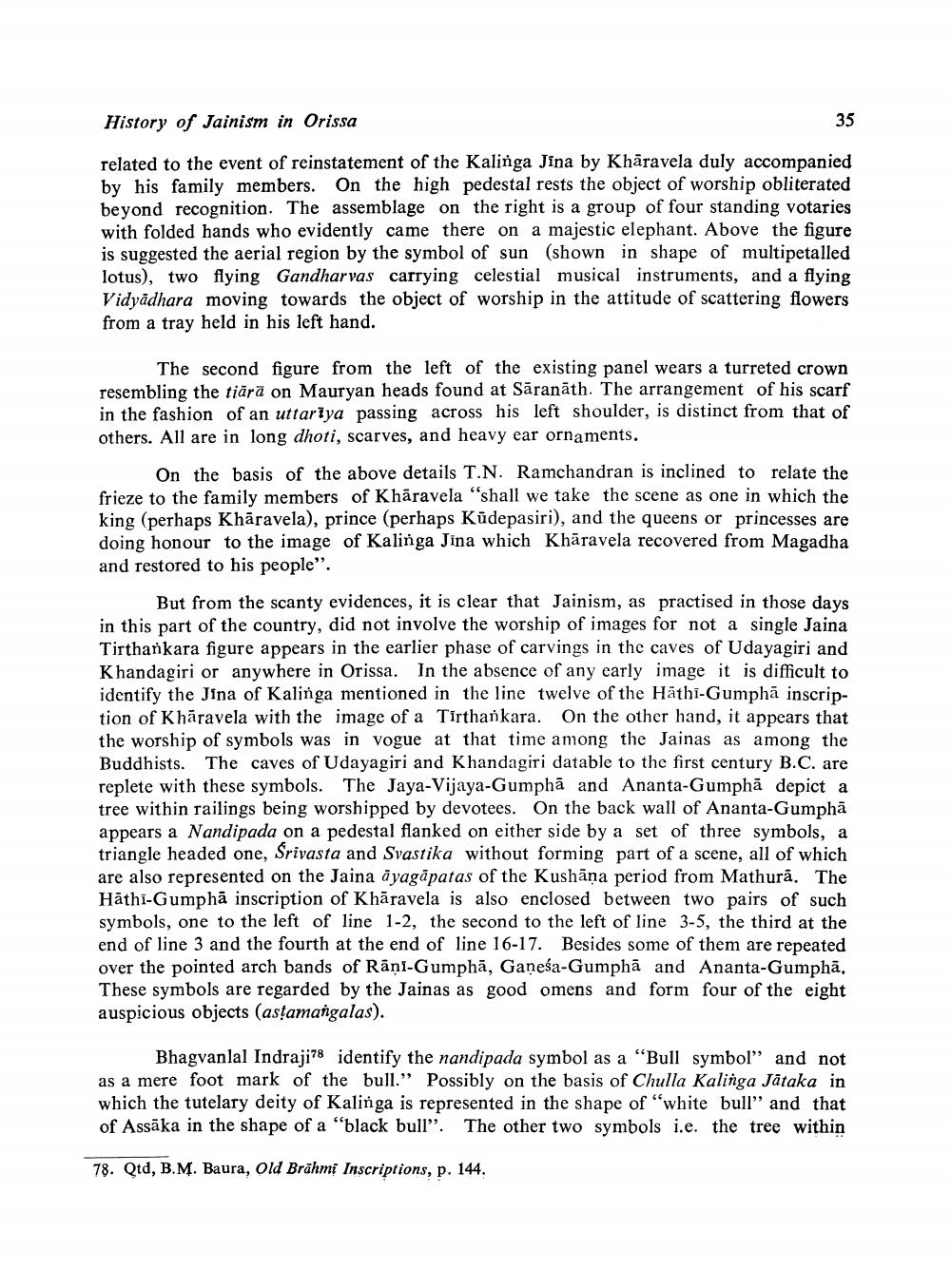________________
History of Jainism in Orissa
35
related to the event of reinstatement of the Kalinga Jina by Khāravela duly accompanied by his family members. On the high pedestal rests the object of worship obliterated beyond recognition. The assemblage on the right is a group of four standing votaries with folded hands who evidently came there on a majestic elephant. Above the figure is suggested the aerial region by the symbol of sun (shown in shape of multipetalled lotus), two flying Gandharvas carrying celestial musical instruments, and a flying Vidyādhara moving towards the object of worship in the attitude of scattering flowers from a tray held in his left hand.
The second figure from the left of the existing panel wears a turreted crown resembling the tiārā on Mauryan heads found at Sāranāth. The arrangement of his scarf in the fashion of an uttariya passing across his left shoulder, is distinct from that of others. All are in long dhoti, scarves, and heavy ear ornaments.
On the basis of the above details T.N. Ramchandran is inclined to relate the frieze to the family members of Khāravela "shall we take the scene as one in which the king (perhaps Khāravela), prince (perhaps Kūdepasiri), and the queens or princesses are doing honour to the image of Kalinga Jina which Khāravela recovered from Magadha and restored to his people".
But from the scanty evidences, it is clear that Jainism, as practised in those days in this part of the country, did not involve the worship of images for not a single Jaina Tirthankara figure appears in the earlier phase of carvings in the caves of Udayagiri and Khandagiri or anywhere in Orissa. In the absence of any early image it is difficult to identify the Jina of Kalinga mentioned in the line twelve of the Hathi-Gumphā inscription of Khāravela with the image of a Tirthankara. On the other hand, it appears that the worship of symbols was in vogue at that time among the Jainas as among the Buddhists. The caves of Udayagiri and Khandagiri datable to the first century B.C. are replete with these symbols. The Jaya-Vijaya-Gumpha and Ananta-Gumphā depict a tree within railings being worshipped by devotees. On the back wall of Ananta-Gumphā appears a Nandipada on a pedestal flanked on either side by a set of three symbols, a triangle headed one, Srivasta and Svastika without forming part of a scene, all of which are also represented on the Jaina āyagāpatas of the Kushāna period from Mathura. The Hāthi-Gumphā inscription of Khāravela is also enclosed between two pairs of such symbols, one to the left of line 1-2, the second to the left of line 3-5, the third at the end of line 3 and the fourth at the end of line 16-17. Besides some of them are repeated over the pointed arch bands of Rāņi-Gumphā, Ganesa-Gumpha and Ananta-Gumphā, These symbols are regarded by the Jainas as good omens and form four of the eight auspicious objects (astamangalas).
Bhagvanlal Indraji78 identify the nandipada symbol as a “Bull symbol” and not as a mere foot mark of the bull." Possibly on the basis of Chulla Kalinga Jātaka in which the tutelary deity of Kalinga is represented in the shape of white bull" and that of Assāka in the shape of a "black bull”. The other two symbols i.e. the tree within
78. Qtd, B.M. Baura, Old Brāhmi Inscriptions, p. 144.




